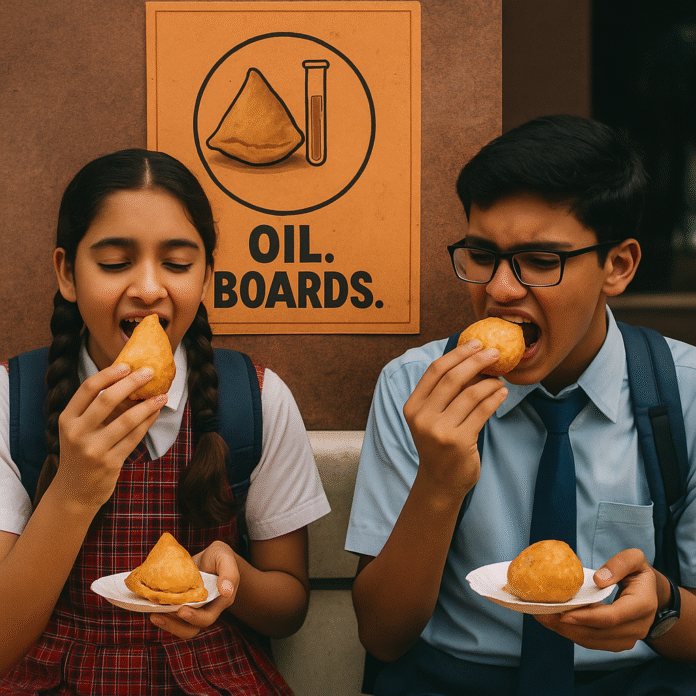India loves its food. Our celebrations begin with ghee, our evenings end with frying pans, and school breaks are incomplete without samosas, Maggi, and mayo-bomb sandwiches. But now, the Central Board of Secondary Education (CBSE) wants to put a small, polite stop sign on your child’s plate.
After last year’s much-talked-about ‘Sugar Boards’, CBSE is now rolling out ‘Oil Boards’ across schools in India—a visual health nudge designed to get kids thinking before they munch.
Why Oil, Why Now?
Because the stats are boiling over.
According to The Lancet, 14.4 million children in India are obese. And no, they’re not gorging on five-star buffets. These are regular kids from regular homes eating everyday Indian delights: vada pavs, buttery parathas, samosas, fries, chips.
Dr. Muffazal Lakdawala, leading bariatric surgeon and founder of Digestive Health Institute, says it best:
“It’s not about demonising food. It’s about awareness and moderation. Kids need visual cues that make them pause. Just like traffic lights.”
What Are ‘Oil Boards’?
Imagine this: a samosa on a plate beside a test tube filled with the actual amount of oil it absorbed. Or a chart showing the oil content in a single plate of fries.
These boards—both posters and digital screens—are being installed in CBSE-affiliated schools across the country.
But the coolest part? They’re designed by students themselves. Think: memes, cartoons, graphs, art, and even reels—made by kids, for kids.
Do These Boards Even Work?
Actually, yes.
When ‘Sugar Boards’ came in, teachers noticed something interesting: kids started asking questions.
“Sir, is brown bread better than white?”
“Ma’am, does Frooti have more sugar than Coke?”
That, says educator Aditi Misra (Director, DPS Gurgaon and Dharav High), is the real win.
“These displays became conversation starters,” she notes.
And now, with ‘Oil Boards’ entering schools, she believes students will start asking equally important questions about the fried fats they’re devouring daily.
Teachers Are Loving It
Ajay Singh, Principal of Scindia School, says the move perfectly blends education with wellness.
“We teach math, science, history—why not food literacy too? These boards act as behavioural nudges. Gentle, visual reminders that what we eat matters.”
Science Backs It Up Too
Dr. Megha Aggarwal, ex-nutritionist at Lok Nayak Hospital, explains that Indian households often lump all fats together.
“But healthy fats like those in nuts and seeds are crucial for brain development,” she says.
“It’s trans fats—the ones in fried snacks and processed junk—that are the problem.”
The ‘Oil Boards’ will help kids (and parents) see the difference between healthy and harmful. One French fry board might do more than a hundred “don’t eat junk” lectures.
Culture vs. Calories
Let’s be real—food is emotion in India. It’s your nani’s poori, your school canteen’s samosa pav, and that crunchy aloo tikki after cricket practice.
The Oil Boards aren’t asking you to give that up.
They’re simply whispering:
“Maybe not every day?”
It’s not a diet chart, it’s a mindset shift. An invitation to eat with awareness, not guilt.
Not a Rule. A Reminder.
This isn’t a top-down broccoli mandate. It’s a student-led, teacher-approved, doctor-backed nudge towards healthier choices.
And in a country where pyaar = food and food = fried, even a small pause can be powerful.
So the next time your kid puts down that second kachori and picks up a fruit—don’t be shocked.
Smile. Thank the Oil Board.








